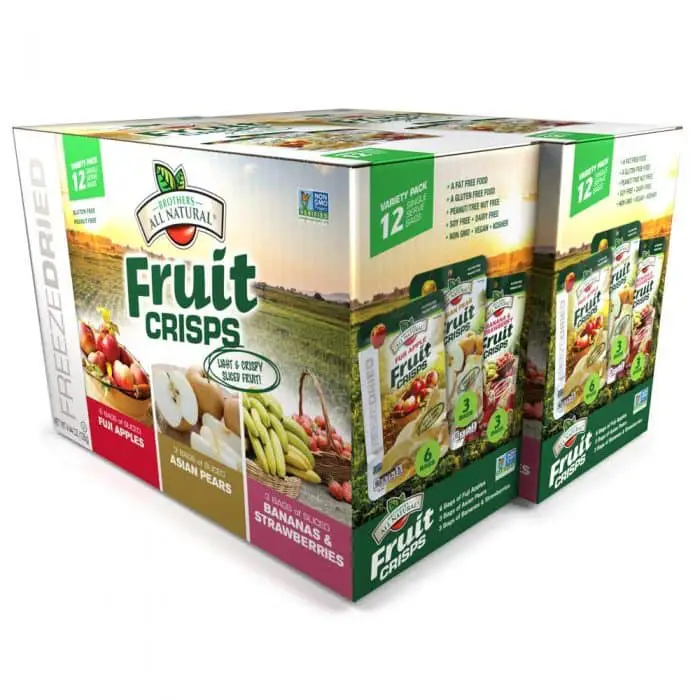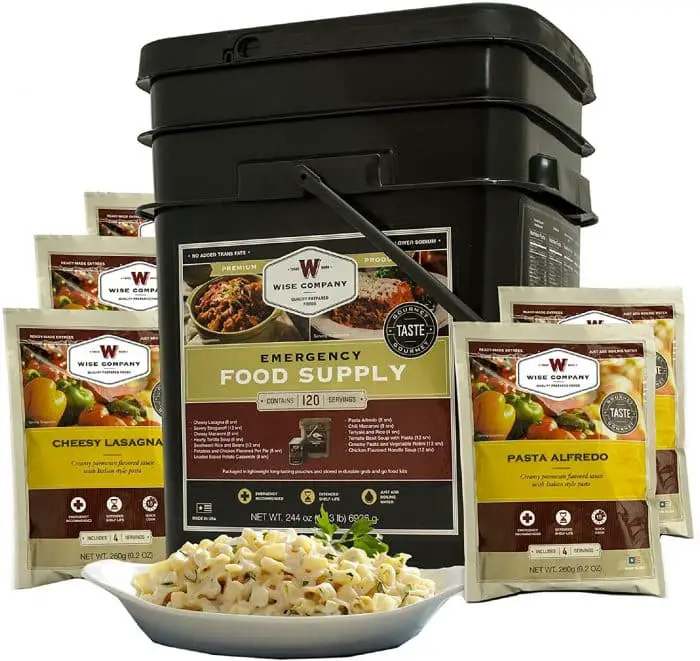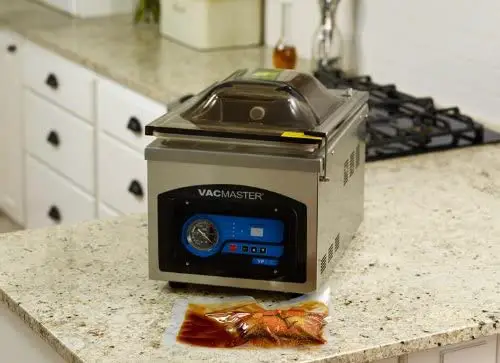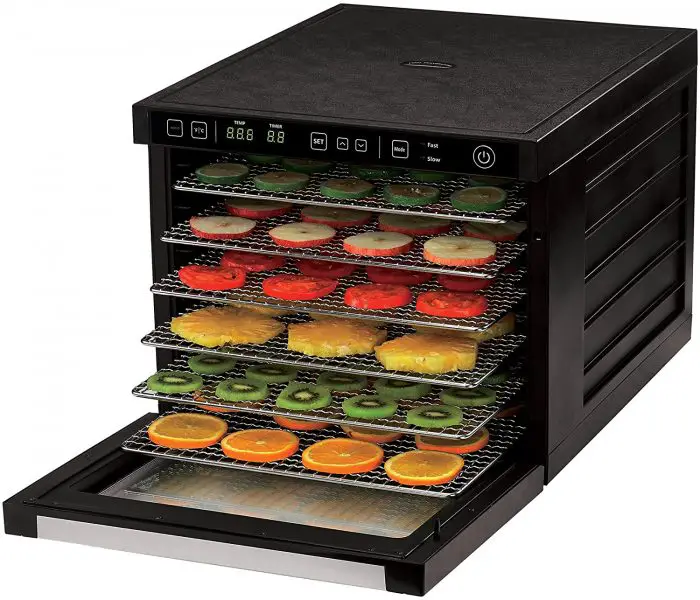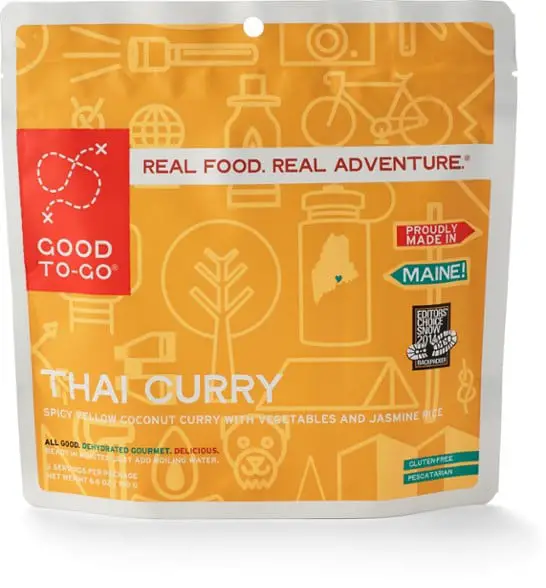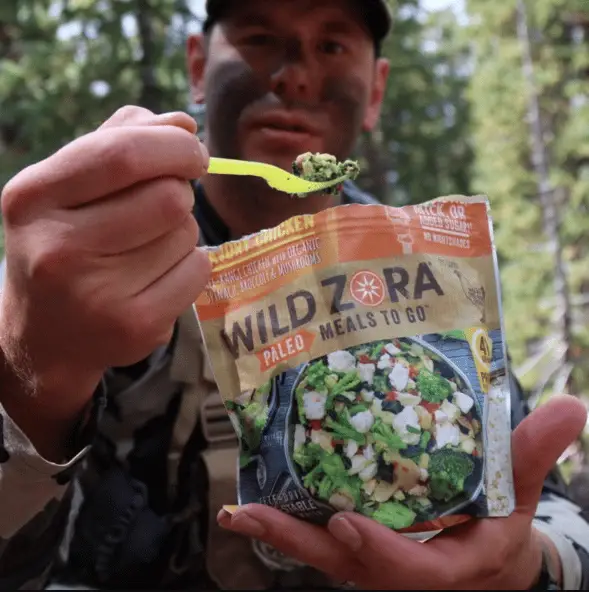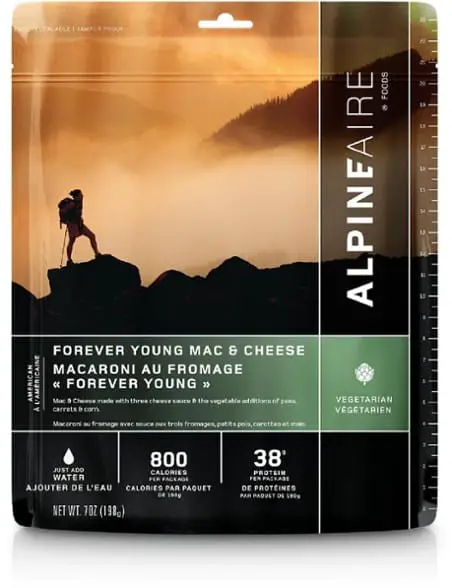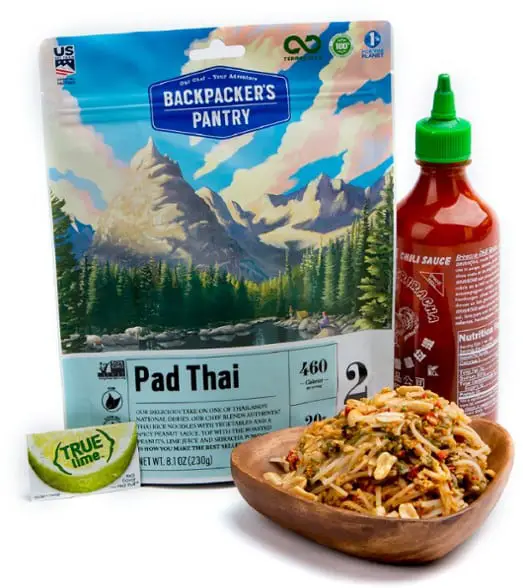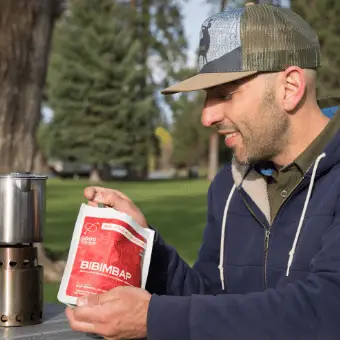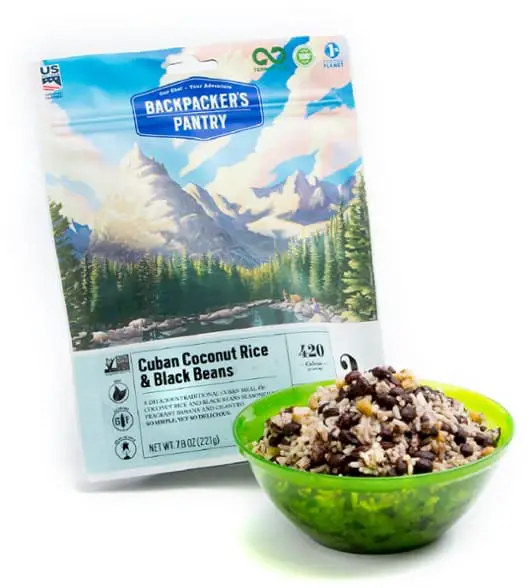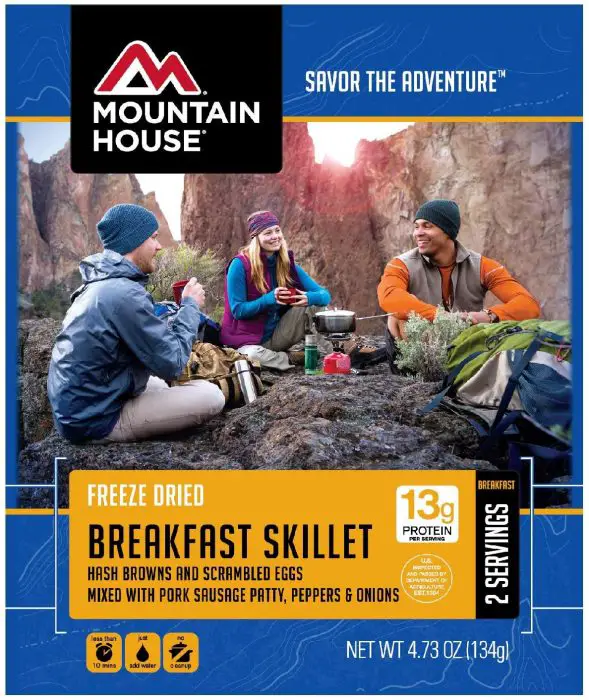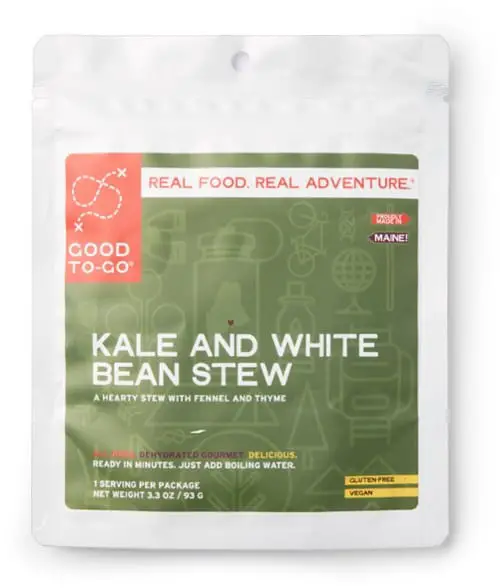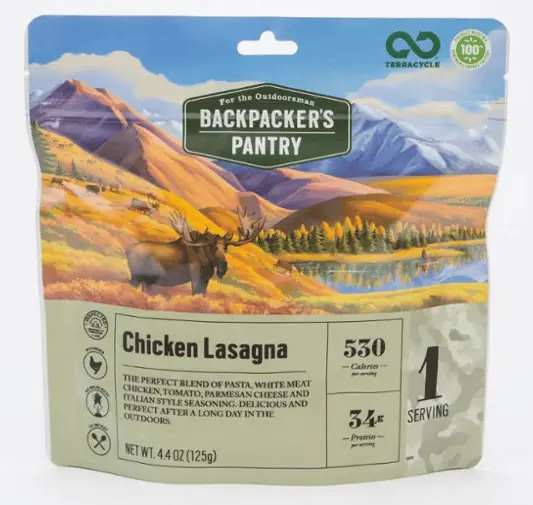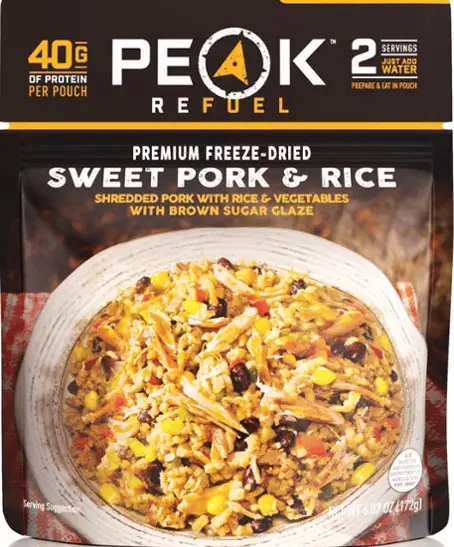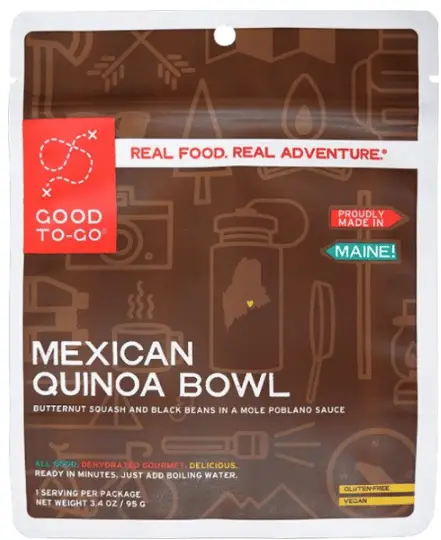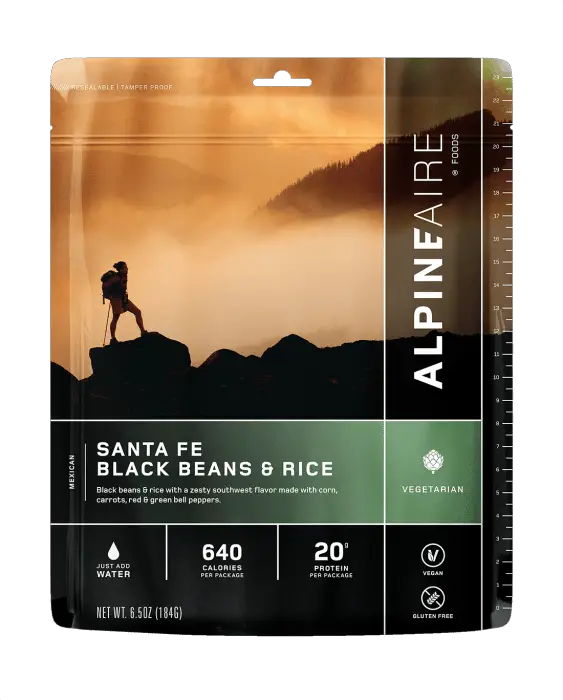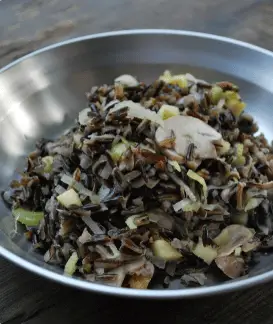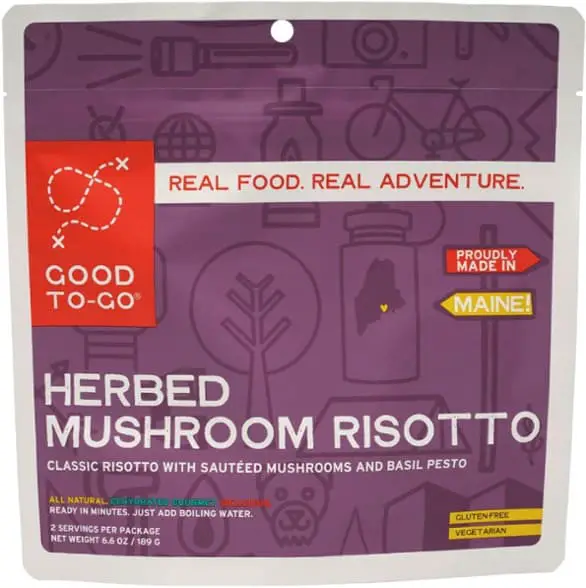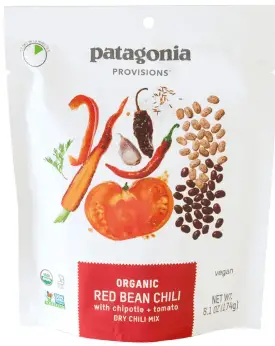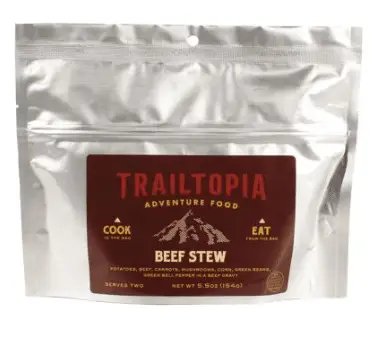Whether you’re stocking up for your next hiking trip or trying to prepare for a natural disaster, food and water are two of your weightiest worries.
But what about storing long-term for emergencies, to bug out, or a spontaneous hiking camping trip?
One type of shelf-stable food that has grown in popularity in recent years is freeze-dried foodstuff.
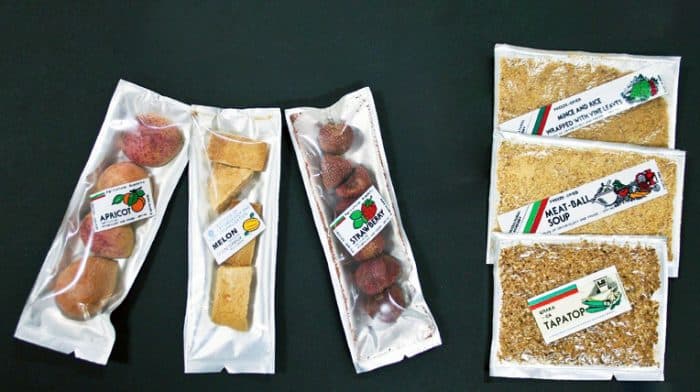
What sets freeze-dried meals apart? Let’s take an in-depth look at freeze-dried meals, how to make them and why you should consider adding them to your camping supplies or bug-out bags.
How to Make Freeze-Dried Food
If you’re familiar with creating shelf-stable foods, you’re probably already used to the idea of drying. Freezing is also a valuable tool for making perishable foods last longer, though it’s only useful if you have a way to keep things cold, so it’s less viable for backpacking or survival scenarios. If you combine the two and add a vacuum, you get freeze-dried food.

Start by placing the food in a freeze dryer. This device carries out all the steps necessary to create your freeze-dried food.
First, it freezes everything at temperatures low enough to ensure that all the water in the food freezes solid.
Then, the dryer will slowly raise the temperature while putting your food under a vacuum. This low-pressure environment causes the water in the material to sublimate — skip the liquid stage and evaporate. It takes a while but can remove upwards of 95% of the water from anything you’re trying to freeze dry.
Finally, the food gets treated to a final desorption stage, which removes any leftover water by raising the temperature, while keeping pressures low. The result is a product that only has 1 to 4% of its original water content.
The lack of water makes freeze-dried foods incredibly self-stable. During the Apollo space missions, most of the food the astronauts enjoyed was freeze-dried, then packaged while still in the vacuum chamber. You can still find some freeze-dried “astronaut ice cream” in museum gift shops.
Cooking and Eating With Freeze-Dried Foods
Preparing and eating freeze-dried foods varies depending on your favorite dishes. Most fruits, vegetables and other similar foods — things you can eat fresh or raw — get freeze-dried in their fresh state.
You can find all sorts of different freeze-dried fruits at your local grocery store if you’re looking for a lightweight snack. You’ll need to cook products like meats before they go into the freeze dryer to ensure they’re safe to eat.
In a pinch, you can eat freeze-dried foods straight out of the package. They’ve still got all the same nutritional value, though they will have the consistency of flavored Styrofoam, and you’ll need a lot of water to wash down your meal. The best way to eat freeze-dried food is to rehydrate it.
Of course, if you’re out in the wilderness, you’re going to want a hot meal after a few hours of exhausting exercise. All you need is a campfire or a camp stove — whatever you can use to heat some water. There are plenty of rocket stove plans online, or they are commercially available
Then, add your food, wait for a few minutes to it to rehydrate and you’ll have a tasty, hot meal to enjoy, no matter where you are. You can pour the water right into the packaging, or you can place the freeze-dried food into a pot or pan and reheat it directly over your campfire.
You can find complete, ready-to-enjoy freeze-dried meals that include everything — proteins, carbohydrates, vegetables and seasoning — or look for the individual ingredients. The latter will enable you to customize your meals, and is ideal for anyone who wants to enjoy the convenience of freeze-dried food, but might have food allergies or other dietary concerns.
Nutritional Value of Freeze-Dried Foods
If you’re packing food for a long hike, the nutritional value will play into your choices. Junk food might be lightweight, but it won’t give you the protein, carbs and fats you need to reach your destination. How do freeze-dried treats stack up against standard camp food?
Reasonably well, as it turns out. For most nutrients, freeze-drying is the best way to store food, with its nutritional profile nearly identical to its fresh counterparts. Some nutrients — like vitamin C, folic acid and vitamin E — lose some of their viability, but others remain the same, regardless of the type of food or how long you store it.
The calorie count of freeze-dried food is identical to what you’d find in a fresh version of the same.
Some items, like fruits, may even taste sweeter than they do when they’re fresh. That’s because when you remove the water, the sugar in the plant’s tissues gets concentrated.
Another benefit of using freeze-dried meals is that other than salt for flavor, they contain very few additives. There’s no need for artificial preservatives when the freeze-drying process does all the preservation for you.
Making Freeze-Dried Foods
Purchasing enough freeze-dried food for your hike or your bug-out bag might not weigh much, but it can be incredibly expensive.
Conventional dehydrated or canned produce is cost-effective, setting you back less than $0.50 per cup, and is even more cost-effective if you’re growing and processing produce from your garden. Commercially freeze-dried food can cost you upwards of $2.50 a cup.
If you’re planning to use a lot of freeze-dried food, it might be smart to start making it from scratch to ensure stocking up won’t break the bank. All you need is a freezer, a vacuum chamber and a packaging system that floods the bags with nitrogen to prevent oxidation and spoilage.
Of course, if that sounds like too much work, you can always invest in a professional freeze dryer that handles everything but the packaging.
The benefit of a professional freeze dryer is that it controls all the temperature changes.
The process takes time, so having a system that takes all the guesswork and babysitting out of it makes it easier to build a stash of freeze-dried foods. Set it and forget it, and enjoy the results when you finish.
A freeze dryer can be a sound investment to help you make the most of seasonal produce as well, especially if you’re a fan of enjoying freeze-dried fruits as an afternoon snack.
Long-Term Storage for Freeze-Dried Foods
If you store it properly, freeze-dried food can last for 25 years or more.
There are two primary things to consider when you’re storing these items — moisture and oxygen.
First, you need to ensure you have fully dehydrated them, and that they have as little water in them as possible. Any water remaining in the freeze-dried foods will contribute to spoilage.
You may find professionally packaged freeze-dried foods in nitrogen instead of oxygen, but for the at-home prepper, that isn’t always an option.
As an alternative, invest in some food-grade oxygen absorbers that you can toss into your bags to remove any remaining oxygen. Don’t forget to store your oxygen absorbers in a sealed container, or they’ll end up useless.
If you take these two variables into account, you’ll have food stores that can last decades — or until next week, when you strike out on your next wilderness adventure.
You can find prepper buckets that provide you with a large selection of freeze-dried meals for closer to wholesale prices, but they may have a shorter shelf life once you open the bucket or sealed container, so make sure you keep that in mind when you’re shopping for freeze-dried meals.
Once you have your freeze-dried meals, you’ll need to find the ideal place to keep them.
Ideally, you’ll want to store your meals at room temperature, but they keep best at temperatures between 32 and 75 degrees Fahrenheit. Cool, dark rooms are best, because exposure to excessive heat can damage sealed supplies.
Try to keep humidity low as well, because moisture is another major concern for these foods.
Keep your freeze-dried foods in sturdy containers or at the top of your pile. The freezing and drying process makes them fragile, so if you pile things on top of them, you’ll have freeze-dried meal powder in no time.
Alternatives to Freeze-Dried Foods
Freeze-drying is a fantastic way to reduce weight and save food, but it requires a lot of patience and costly equipment.
Thankfully, it isn’t the only way to lighten your load when you’re packing for a trip. Standard dehydrated foods won’t last as long, but you can still get 15 to 20 years out of them.
As a bonus, you don’t need any extra equipment to dehydrate your meals. All you need is an oven!
Use the same rules of thumb for storing dehydrated foods that you would use for storing freeze-dried ones. Be mindful of moisture content, and keep as much oxygen out of the packaging as possible. You can dehydrate nearly anything, from meat and produce to things like pasta sauce, so you can quickly whip up a tasty Italian-inspired dish even though you’re far from home.
If you’re looking for ultralight foods to stash in your pack before your next trip, freeze-dried or dehydrated foods are a fantastic choice.
Depending on your location and skill set, you also have the option of hunting, fishing or foraging for your meals while you’re out on the trail.
Doing so can help keep your pack’s weight down, though you will need to bring things like fishing rods and tackle or tools for hunting if you decide to take this route. There are a few things you’ll want to keep in mind if you’re going to hunt or fish.
First, make sure whatever you’re harvesting is in season and is legal to keep for the state or city you’re in. Some fish species might be illegal to keep, and for land-based game, you may have to wait for a specific hunting season or obtain a hunting license.
If you’re planning to forage, be 100% sure of what you’re eating. Plenty of entirely toxic plants look like food, so ensure your tasty treats aren’t going to kill you.
When it comes to mushrooms, you’ll want to be certain beyond the shadow of a doubt that the varieties you’re foraging are edible. Many toxic mushrooms look nearly identical to their edible counterparts. If you’re not confident, leave them where you found them.
Finally, make sure you have something in your pack to supplement your diet in case you have trouble hunting or fishing for your dinner.
The last thing you want to do when you’re out on the trail is to go to bed hungry. Make sure you’re getting enough calories to keep you moving, or you might find it challenging to make it home at the end of your trip.
The 20 Best Freeze-Dried Foods
Now that we know what freeze-dried foods are and how you can use them, let’s take a closer look at the 20 best freeze-dried foods currently available, based on price, convenience and, of course, flavor.
Some of these come in veggie or vegan-friendly varieties, so we’ll be sure to note that on each description.
1. Good To-Go Thai Curry
There’s nothing like a bit of extra spice to perk you up, especially when you’re out hiking during the colder months.
Good To-Go captures the flavor of authentic Thai curry, including all the spice. Don’t pick this one up if you don’t like a bit of heat — it doesn’t come with the kind of spice level options you’d get at a restaurant.
It’s a little pricey, but one pack creates two servings, so you’ve got plenty for you and your hiking partner — or to eat on your own if you’re hiking solo or ravenous after a long day of exploring.
Pair it with some spicy Thai crackers or a splash of sriracha for some extra heat.
2. Paleo Meals Summit Savory Chicken
It can be tricky to find backpacking foods that fit with the paleo or keto diets because carbohydrates are such an essential macronutrient — especially when you’re out being active.
Paleo Meals gives you an incredibly tasty freeze-dried chicken and vegetable dish that is perfect for anyone following the paleo diet. You’ll need to stock up if you’re planning to share, though — each pack only contains a single serving of chicken and veggies, though it does have a whopping 41 grams of protein packed into each serving.
If you’re concerned about a lack of carbs for energy, pair it with some pasta, rice or instant mashed potatoes.
3. AlpineAire Foods Forever Young Mac and Cheese
It doesn’t matter where you are — sometimes you crave comfort foods like mac and cheese. Of course, hauling perishables like butter and milk into the wilderness isn’t usually a practical option. That’s where AlpineAire’s freeze-dried foods come in.
This dish is a tasty replacement for your favorite cheesy comfort foods, and comes with two servings, giving you more than enough to share. Make sure you’re adding some protein to your diet, because humans can’t live on carbs alone — no matter how much we’d like to.
Mac and cheese is perfect by itself, but if you need a little bit of extra flavor, top it with some toasted breadcrumbs or fried onions.
4. Backpacker’s Pantry Pad Thai Veggie (Vegan)
Thai food seems to be a trend in freeze-dried backpacking suppliers, and with good reason. It’s easy to pack a ton of flavor into Thai food, even if it’s freeze-dried and needs rehydrating.
It comes with all sorts of condiments to add to your experience, from peanuts and peanut butter to lime juice and sriracha, so you can customize your meal to your liking. Add some heat or leave out the spice in favor of flavor. The choice is up to you. We’ve linked to the veggie version of this freeze-dried meal, but Backpacker’s Pantry also sells pad Thai with chicken for the carnivores in the audience.
Pad Thai is a meal in itself, but you can always add some beans or other vegan protein sources if you need to boost your macros a bit.
5. Mountain House Chili Mac
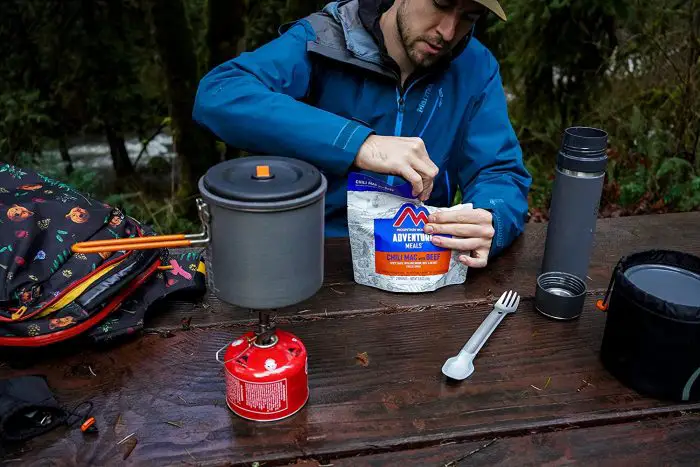
If you’ve ever seen freeze-dried meals at your local Walmart, you’re probably familiar with the Mountain House brand.
Add some boiling water, and you’ll have a super-tasty pouch of chili mac in no time. It might not be the fanciest brand, but if you want some affordable freeze-dried food that will keep you going no matter where you are, Mountain House Chili Mac should be on your shopping list. Plus, it’s a bit more substantial than plain old mac and cheese, so you don’t have to add extra components to your meal.
A warm flatbread is a perfect accompaniment to a bowl of chili mac. Stash some in your pack and warm them up on a stone next to the fire.
6. Good To-Go Bibimbap (Vegan)
If you’re looking for yummy vegan options to keep you fed on your trip, you’ve got plenty to choose from. One of our favorites is the bibimbap from Good To-Go.
The name translates to “mixed rice,” but it’s bursting with vegetables and some delicious Korean flavor you won’t be able to get enough of, even if you don’t usually follow a vegan diet. It’s got a bit of a spicy kick, just like traditional bibimbap, so get ready for some burn if you decide to add this freeze-dried meal to your backpack.
If you’re not sticking to a vegan diet, consider frying an egg and dropping it on top of your bibimbap for a bit of extra protein and some authentic Korean flavor.
7. Backpacker’s Pantry Cuban Coconut Beans and Rice (Vegan)
Bring the flavors of the Caribbean to your campsite, even if you’re a thousand miles from the nearest ocean.
This tasty freeze-dried dish combines rice with black beans, coconut and bananas to create a flavor sensation so tropical that you’ll think you’re lying on the beach. Eat it straight from the pouch, or drop it onto some tortillas and top it with fresh tomato and avocado or some freeze-dried instant guac for a delicious meal, no matter where you’re pitching your tent.
8. Mountain House Breakfast Skillet
So far, we’ve focused on dinners, but that isn’t the only meal you’ll be eating while you’re out on the trail.
When it comes to breakfast foods, the breakfast skillet by Mountain House is one of our favorites. It combines hash browns, scrambled eggs, sausage, onions and peppers into a downright delicious breakfast. It’s got 13 grams of protein and 25 grams of carbohydrates, giving you plenty of energy to start your day.
Surprisingly, scrambled eggs freeze-dry excellently, and they’re essentially pure protein, so if you’re making freeze-dried meals, this is a great place to start.
9. Peak Refuel Chicken Alfredo Pasta
You can never go wrong with pasta, no matter where you are.
We love Peak Refuel’s freeze-dried chicken Alfredo because it packs all the flavor you’d expect from your favorite pasta dish into a lightweight, freeze-dried package perfect for hiking or prepping. It also needs less water than many of the other examples on this list.
All you need is one and a third cups of boiling water to create the perfect trail meal. It has a shelf-stable guarantee of five years — less than you might expect for freeze-dried food, but more than sufficient if you’re using it for hiking and backpacking.
Don’t forget a side of garlic bread to round out your chicken Alfredo dinner. Yum!
10. Good To-Go Kale and White Bean Stew (Vegan)
Kale has earned a bit of a bad reputation for being the stereotypical “health food,” but if you cook it right, it can be delightful.
That’s just what you get with this tasty kale and white bean stew. It pairs the two titular ingredients with flavorful ingredients like fennel, garlic and rosemary for a filling dinner that will warm you up, no matter where you’re camping.
The white beans provide a vegan-friendly protein substitute that tastes delicious, too.
11. Backpacker’s Pantry Outdoorsman Chicken Lasagna
Who doesn’t love lasagna?
This super-tasty freeze-dried chicken lasagna has plenty of protein and calories, making it the perfect choice for dinner after a long hike. Just add a cup and a half of water, let it sit for 15 minutes and you’re good to go.
If you’re concerned about the sustainability of your freeze-dried meals, stick with Backpacker’s Pantry. They offer a service called TerraCycle that allows you to send back your empty pouches for free recycling.
12. Peak Refuel Sweet Pork and Rice
It’s sweet, savory and one of the tastiest freeze-dried meals on our list.
Enjoy a yummy dinner that pairs shredded pork and rice with all sorts of vegetables and beans for a portable protein-packed meal that only takes one and a third cups of water to rehydrate.
It’s not only flavorful, but it also has enough heat to warm you up on cold nights.
13. Good To-Go Mexican Quinoa Bowl (Vegan)
Quinoa is a superfood that has skyrocketed in popularity in recent years.
It cooks quickly and easily like rice, but contains a ton of protein and nutrients you’ll need to keep you going on a long hike.
This tasty freeze-dried meal pairs quinoa with black beans and butternut squash, tossing all of it in a mole poblano sauce that is so good you’ll be begging for the recipe. Who says vegan food has to be boring?
14. AlpineAire Foods Santa Fe Black Beans and Rice (Vegan)
Black beans and rice is a staple meal, especially when you pair it with all sorts of nutritious vegetables.
AlpineAire’s version of this classic dish will satisfy even the pickiest eater. It doesn’t have a lot of spice, but you won’t be disappointed by the serious flavors packed into this freeze-dried dinner.
Pair it with some tortillas and guacamole or your favorite freeze-dried protein.
15. Backpacker’s Bistro Wild Rice and Mushroom Pilaf (Vegan)
This brand offers gourmet freeze-dried meals you can take anywhere.
Their super-tasty interpretation of wild rice and mushroom pilaf contains 11 grams of protein and 62 grams of carbs. It might not be keto-friendly, but it’s a perfect choice if you need a flavorful vegan option.
Veggie stock, apples, leeks, celery, garlic and thyme create the ideal flavor profile. Each package makes two servings, so you’ve got plenty to share with your hiking or backpacking partner.
16. MaryJanesFarm Organic Shepherd’s Meat Pie
Shepherd’s pie is a stick-to-your-ribs comfort food classic.
This instant freeze-dried meal has all the components you’d find in your favorite homemade shepherd’s pie — from ground beef and mashed potatoes to cheese and vegetables — in a lightweight, easy-to-carry package perfect for backpackers.
It’s a little heavy on the salt, but you’ll enjoy 15 grams of protein and 36 grams of carbs, which is the perfect way to wrap up your day.
17. Good To-Go Herbed Mushroom Risotto (Vegan)
Risotto is one of our favorite go-to hot meals after a long day on the trail.
You don’t even have to buy a freeze-dried version — bring your favorite arborio rice and stock cubes and you’re all set — but that can get a bit old after a while. This freeze-dried meal offers some intense flavor, with mushrooms, herbs and basil pesto, so you’ll never have to worry about eating an uninspiring dinner.
This risotto is perfect by itself, but it also goes brilliantly with any protein you want to add — vegan or otherwise.
18. Nomad Nutrition Hungarian Goulash (Vegan)
Goulash is a trail food that dates back to the ninth century.
Travelers would carry dehydrated meat with them, using water to rehydrate it whenever they needed a meal.
This incarnation of the classic traveling food doesn’t have any animal products, making it ideal for vegan hikers and backpackers, but it doesn’t skimp on tastiness. It gets all its flavor from peppers, smoked paprika and olive oil, plus delicious kidney beans and potatoes.
19. Patagonia Provisions Organic Red Bean Chili (Vegan)
If you ask 10 different people for their chili recipes, you’ll get 10 different answers.
This vegan-friendly red bean chili has all the flavor and heat of a home-cooked meal, without the hassle of breaking out the cooking pots while you’re out on the trail. The chili has 14 grams of protein, thanks to the beans used for its base, as well as 12 grams of healthy fiber.
The best thing to accompany a piping hot bowl of chili is warm, crumbly cornbread. If you’re thinking of adding some bread to your food supplies, bring a couple of corn muffins for chili night.
20. Trailtopia Adventure Food Beef Stew
After a long day on the trail, sometimes all you want is some hot comfort food.
Why not have a hearty helping of beef stew? This package includes everything from meat and potatoes to all the vegetables you’d want from a bowl of beef stew. With two full servings and a five-year shelf life, you won’t go to bed hungry with one of these freeze-dried meals in your pack.
Choosing Your Favorite Freeze-Dried Dinners
These are just a few examples of our favorite freeze-dried backpacking meals, but there are plenty available. You’re sure to find something to suit your tastes and your nutritional needs.
Did we miss your favorite backpacking meal?
Let us know in the comments below — we’re always looking for new, tasty dishes to take with us on our next adventures.

